
Trends in Chemistry
Scope & Guideline
Exploring the Future of Chemical Innovation
Introduction
Aims and Scopes
- Catalysis Innovations:
The journal highlights breakthroughs in various catalytic processes, including transition metal catalysis, photocatalysis, and enzyme engineering, showcasing advances that enhance reaction efficiency and selectivity. - Sustainable Chemistry:
A core focus on sustainable practices within chemistry, involving the development of green methodologies, bio-based materials, and approaches to valorize waste, aiming to reduce environmental impact. - Material Science and Nanotechnology:
Exploration of novel materials, particularly in nanotechnology, organic electronics, and energy storage, emphasizing their applications in real-world problems such as energy conversion and storage. - Chemical Biology and Medicinal Chemistry:
Research that bridges chemistry with biology, emphasizing the design of bioactive compounds, drug delivery systems, and the application of chemical principles in biological contexts. - Computational Chemistry and Machine Learning:
Integration of computational methods and machine learning techniques to predict chemical behavior, optimize reactions, and drive innovations in material discovery. - Interdisciplinary Approaches:
Encouragement of collaborative research that combines elements from physics, engineering, and biology to tackle complex chemical challenges.
Trending and Emerging
- Digital and Computational Chemistry:
An increasing number of studies are utilizing computational methods and machine learning to enhance chemical research, indicating a trend towards data-driven approaches in catalysis and materials science. - Sustainable and Green Chemistry:
There is a notable rise in research focused on sustainability, including the development of eco-friendly processes, bioplastics, and waste valorization techniques, emphasizing the importance of environmental considerations. - Advanced Materials for Energy Applications:
Emerging themes include the design and application of advanced materials for energy storage and conversion, such as batteries and solar cells, reflecting a strong interest in energy sustainability. - Photocatalysis and Light-Driven Reactions:
The exploration of photocatalytic processes and light-driven reactions is on the rise, showcasing innovative methods for chemical transformations and environmental remediation. - Biomimetic and Bioorthogonal Chemistry:
Research in biomimetic strategies and bioorthogonal reactions is gaining momentum, indicating a trend towards integrating biological principles into chemical design and synthesis.
Declining or Waning
- Traditional Organic Synthesis:
There is a noticeable decrease in studies focused solely on classical organic synthesis methods, as the field increasingly embraces more innovative and efficient approaches. - Inorganic Coordination Chemistry:
Research specifically centered on traditional coordination compounds has become less prominent, as the focus shifts towards more complex systems and applications. - Conventional Drug Discovery:
The emphasis on traditional drug discovery processes appears to be waning, with a growing preference for novel methodologies such as biomimetic approaches and targeted delivery systems. - Basic Theoretical Studies:
Papers focusing solely on basic theoretical chemistry without immediate practical applications have become less frequent, as applied research gains more attention. - Homogeneous Catalysis Without Novel Applications:
Research centered exclusively on homogeneous catalysis without linking to practical applications or innovative methods has seen a decline, highlighting a trend towards more impactful studies.
Similar Journals
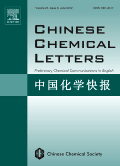
CHINESE CHEMICAL LETTERS
Advancing Knowledge, Shaping the Future of Chemistry.CHINESE CHEMICAL LETTERS, published by Elsevier Science Inc, is a premier journal in the field of chemistry, notably recognized for its focus on innovative research in multidisciplinary areas of the discipline. With its ISSN 1001-8417 and E-ISSN 1878-5964, this journal has established itself as a valuable resource for academics since its inception in 1996, with coverage extending to 2024. Categorized in the top tier (Q1) for Chemistry (miscellaneous), it ranks an impressive #37 out of 408 in Scopus's General Chemistry category, reflecting its significant influence and contribution to the field, with a remarkable 91st percentile ranking. Though it does not currently offer open access, CHINESE CHEMICAL LETTERS remains accessible to researchers through institutional subscriptions and provides crucial insights and advancements in chemical research, making it an essential publication for professionals and students aiming to stay at the forefront of chemical sciences.
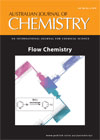
AUSTRALIAN JOURNAL OF CHEMISTRY
Unveiling innovative research in the heart of Australia.The Australian Journal of Chemistry, with an ISSN of 0004-9425 and an E-ISSN of 1445-0038, is a distinguished publication from CSIRO PUBLISHING, dedicated to advancing the field of chemistry since its inception in 1948. Based in Australia, this journal serves as a platform for original research articles, reviews, and innovative studies that encompass a wide spectrum of chemical disciplines, aiming to foster communication and collaboration among researchers globally. Despite its Q3 ranking in the Chemistry (Miscellaneous) category and standing at rank #236 in Scopus’ general chemistry classification, it remains an essential resource for professionals and students seeking to stay informed about emerging trends and discoveries in chemistry. The journal does not offer open access, emphasizing the premium quality of peer-reviewed content that adheres to rigorous academic standards. By bridging theory and practice, the Australian Journal of Chemistry continues to play a crucial role in shaping the future of chemical sciences.

JOURNAL OF THE INDIAN CHEMICAL SOCIETY
Fostering Innovation in Diverse Chemical DisciplinesJournal of the Indian Chemical Society, published by Elsevier, stands as a cornerstone in the field of chemistry, particularly representing the rich chemical research emanating from India.
With a significant history dating back to its establishment, this journal encompasses diverse disciplines including Drug Discovery, Electrochemistry, Inorganic Chemistry, Organic Chemistry, and Physical and Theoretical Chemistry, reflecting the evolving landscape of chemical sciences.
Despite being positioned in the Q3 category across multiple quarters, the journal demonstrates promising rankings in various chemistries, highlighting its commitment to advancing the knowledge and application of chemical sciences. While currently not available as an open access journal, the Journal of the Indian Chemical Society is dedicated to providing a platform for high-quality research that fosters innovation and collaboration among researchers, professionals, and students worldwide.
With its continuous publication from 1973 to the present, it serves as an essential repository for cutting-edge findings and developments in chemistry, striving to connect academia with industry and practice.

RUSSIAN CHEMICAL BULLETIN
Connecting Researchers through Pioneering Chemical Insights.RUSSIAN CHEMICAL BULLETIN, published by SPRINGER, serves as a pivotal resource in the field of general chemistry, covering a wide array of topics that impact both theoretical and applied chemistry. With an ISSN of 1066-5285 and a presence since 1993, this journal provides a platform for disseminating significant research findings, practical applications, and novel methodologies within the broader chemistry community. While it currently holds a Q3 ranking in the Chemistry (miscellaneous) category and occupies the 230th position out of 408 in the Scopus rankings, its reputation continues to grow, fostering collaboration and innovation among researchers and professionals alike. Although the journal does not offer an open-access model, it is committed to making findings accessible within the academic community, ensuring that valuable insights can inform future research. With an anticipated convergence of studies extending to 2024, the RUSSIAN CHEMICAL BULLETIN remains an essential reference for those dedicated to advancing chemical science.
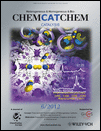
ChemCatChem
Exploring the Frontiers of Chemical Innovation.ChemCatChem is a leading international journal published by WILEY-V C H VERLAG GMBH that has been making significant contributions to the fields of catalysis, inorganic and organic chemistry, as well as physical and theoretical chemistry since its inception in 2009. With an established reputation for excellence, this journal holds commendable rankings in various categories, including Q1 in Inorganic Chemistry and Q1 in Organic Chemistry, demonstrating its pivotal role in advancing scientific knowledge and innovation. Notably, it has achieved a high Scopus ranking, securing 10th place out of 79 in Inorganic Chemistry, among others, showcasing its influence and quality. Although open access options are not available, the journal offers cutting-edge research articles, reviews, and insights that are vital for researchers, professionals, and students aiming to stay at the forefront of chemical science. With its address rooted in Weinheim, Germany, and convergence projected to continue until 2024, ChemCatChem remains a dynamic platform for disseminating vital advancements within the chemical community.
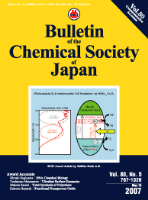
BULLETIN OF THE CHEMICAL SOCIETY OF JAPAN
Showcasing Excellence: A Nexus for Chemical ScholarshipBULLETIN OF THE CHEMICAL SOCIETY OF JAPAN, published by the esteemed Chemical Society of Japan, serves as a pivotal platform for the dissemination of cutting-edge research in the multifaceted field of chemistry. With an ISSN of 0009-2673 and an E-ISSN of 1348-0634, this journal has been integral in fostering the growth of chemical sciences globally since its inception in 1965. The journal holds an impressive Q2 ranking in the Chemistry (miscellaneous) category, indicating its relevance and influence within the academic community, as reflected by its Scopus rank of #104/408, placing it in the 74th percentile. Although it is not an open-access journal, its rich content, which spans a wide range of topics in general chemistry, remains highly valued by researchers, professionals, and students alike, affirming its crucial role in advancing both theoretical knowledge and practical applications in chemistry. As it converges towards 2024, the bulletin continues to uphold its commitment to excellence in scientific communication and research dissemination in Japan and beyond.
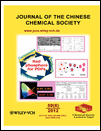
JOURNAL OF THE CHINESE CHEMICAL SOCIETY
Fostering Knowledge in the Evolving World of ChemistryJOURNAL OF THE CHINESE CHEMICAL SOCIETY, published by WILEY-V C H VERLAG GMBH, is a vital resource in the field of chemistry, focusing on a broad array of topics pertinent to general chemistry and its advancing sub-disciplines. Established in 1954 and running through 2024, this journal serves as a significant platform for the dissemination of high-quality research, showcasing innovative findings and developments within the chemical sciences. With its Q3 category ranking and positioning at Rank #203 in General Chemistry per Scopus, it reflects the journal's commitment to research excellence and impact. While not an open-access publication, it ensures accessibility to a global audience, making it an essential tool for researchers, professionals, and students alike seeking to stay informed and engaged in the evolving landscape of chemistry.

Chem
Leading the Charge in Open Access Chemical ResearchChem, published by CELL PRESS, is a renowned academic journal that has rapidly established itself as a leading platform for cutting-edge research in diverse areas such as biochemistry, chemical engineering, materials chemistry, and environmental chemistry. Released under the ISSN 2451-9294, this esteemed journal has achieved an impressive Q1 category ranking across multiple disciplines in 2023, highlighting its significant impact and prominence within the academic community. With a strong focus on innovative studies and interdisciplinary approaches, Chem fosters a vibrant dialogue among researchers, professionals, and students, making it an indispensable resource for those seeking to advance their knowledge and contribute to the evolving field of chemistry. As an open access journal, it aims to democratize knowledge, ensuring that critical research is accessible to a global audience. With its headquarters based in Cambridge, MA, it continues to lead the charge in the dissemination of pivotal findings that shape our understanding of chemical sciences.

RSC Advances
Exploring Cutting-Edge Discoveries in Chemical SciencesRSC Advances, published by the Royal Society of Chemistry, is a leading open-access journal that has been a prominent platform for cutting-edge research since its inception in 2011. Recognized globally for its rigorous peer-review process, RSC Advances serves the dynamic fields of Chemical Engineering and Chemistry, holding prestigious rankings within the top quartile of academic journals in both areas. With its impact factor reflecting a growing influence, the journal currently occupies the Q1 category in Chemical Engineering and Q2 in Chemistry as of 2023. Researchers and professionals will find RSC Advances an essential resource for innovative studies and applications that advance scientific knowledge. Additionally, as an open access journal since 2017, it affords wider visibility and accessibility to groundbreaking research, fostering collaboration and engagement in the scientific community. Situated in Cambridge, UK, RSC Advances remains committed to its objective of disseminating high-quality research that catalyzes progress across various disciplines.

INORGANIC CHEMISTRY
Shaping the Future of Inorganic Science Through ResearchInorganic Chemistry, published by the American Chemical Society, stands at the forefront of the field of inorganic and physical chemistry, boasting an impressive impact in the academic community with a 2023 classification in the Q1 quartile across multiple categories including Inorganic Chemistry and Miscellaneous Chemistry. Since its inception in 1962, this esteemed journal has been a crucial platform for disseminating groundbreaking research, innovative methodologies, and comprehensive reviews integral to understanding the complex behaviors of inorganic materials. With a ranking of #12 out of 79 in Inorganic Chemistry and #37 out of 189 in Physical and Theoretical Chemistry according to Scopus metrics, Inorganic Chemistry has established itself as a premier destination for researchers, professionals, and students alike, eager to stay abreast of pivotal developments and trends in the discipline. Despite being a subscription-based journal, its esteemed reputation and critical contributions make it essential for anyone engaged in the exploration of inorganic chemical phenomena. As it prepares to converge into a new era by 2024, the journal continues to embody excellence and innovation, fostering a dynamic exchange of ideas essential for advancing this vibrant area of science.